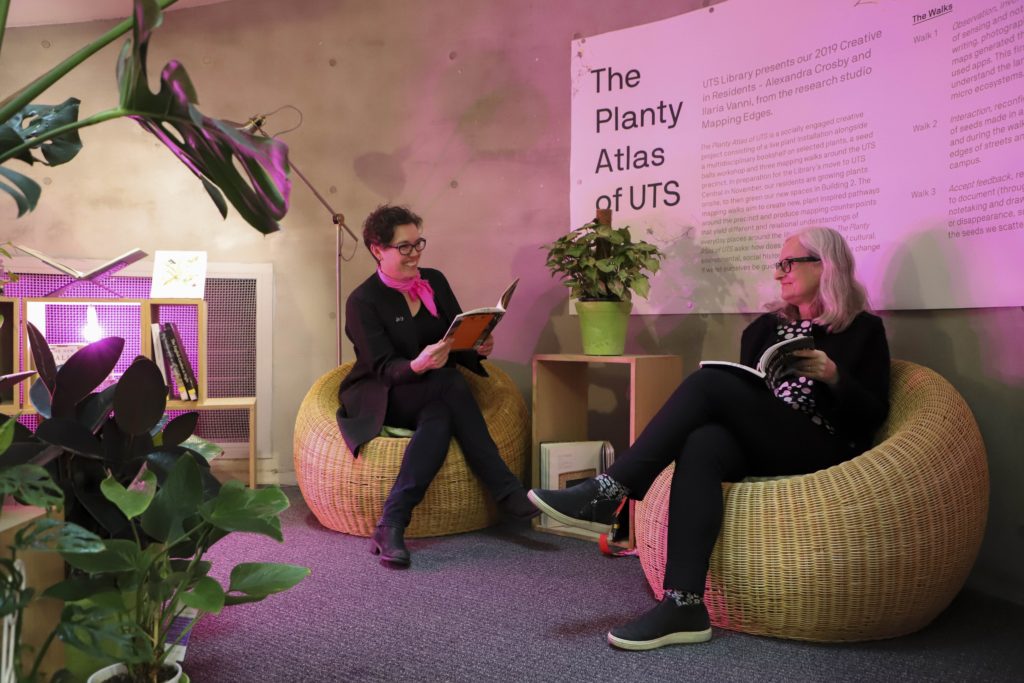As part of the planty bookshelf, we put together a list of digital resources to help with planty research.
- Atchison, J. (2019). Thriving in the Anthropocene: Understanding Human-Weed Relations and Invasive Plant Management Using Theories of Practice. In Social Practices and Dynamic Non-Humans (pp. 25–46). Cham: Springer International Publishing.
- Baluška, F., Gagliano, M. & Witzany, G. 2018, Memory and learning in plants, Springer, Cham, Switzerland.
- Brice, Jeremy. “Attending to Grape Vines: Perceptual Practices, Planty Agencies and Multiple Temporalities in Australian Viticulture.” Social and Cultural Geography, 2014.
- Clément, Gilles The Planetary Garden and Other Writings. Philadelphia: University of Pennsylvania Press, 2015.
- Dixon, T. & Wilkinson, S. (eds) 2016, Green Roof Retrofit : Building Urban Resilience, Wiley, London.
- Coccia, Emanuele. The Life of Plants: A Metaphysics of Mixture. Cambridge: Polity Press, 2019.
- Crosby, Alexandra Lara, Jacquie Lorber-Kasunic, and Ilaria Vanni Accarigi. “Value the Edge: Permaculture as Counterculture in Australia.” M/C Journal 17, no. 6 (2014): 1–10
- Gibson-Graham JK, and Gerda Roelvink. “An Economic Ethics for the Anthropocene.” Antipode., (2010). 10.1111/j.1467-8330.2009.00728. x.
- Head, L. & Atchison, J. 2009, ‘Cultural ecology: Emerging human-plant geographies’, Progress in Human Geography, vol. 33, no. 2, pp. 236–45.
- Head, L., Atchison, J., Phillips, C. & Buckingham, K. 2014, ‘Vegetal politics: belonging, practices and places’, Social & Cultural Geography, vol. 15, no. 8, pp. 861–70.
- Head, L. (2017). Cultures of Nature. In International Encyclopedia of Geography: People, the Earth, Environment and Technology (pp. 1–6). Oxford, UK: John Wiley & Sons, Ltd.
- Hustak, C., & Myers, N. (2013). Involutionary Momentum: Affective Ecologies and the Sciences of Plant/Insect Encounters. Differences, 23(3), 74–118.
- Lang, U. 2014, ‘The common life of yards’, Urban Geography, vol. 35, no. 6, pp. 852–69.
- Mancuso, S. 2015, Brilliant green : the surprising history and science of plant intelligence, Island Press, Washington Covelo London.
- Morgan, G., Rocha, C. & Poynting, S. 2005, ‘Grafting Cultures: Longing and Belonging in Immigrants’ Gardens and Backyards in Fairfield’, Journal of Intercultural Studies, vol. 26, no. 1–2, pp. 93–105, viewed 3 July 2017.
- Myers, Natasha. “From the Anthropocene to the Planthroposcene: Designing Gardens for Plant/People Involution.” History and Anthropology 28, no. 3 (2017): 297–301. https://doi.org/10.1080/02757206.2017.1289934.
- Pascoe, Bruce. Dark emu black seeds: Agriculture or accident?. Magabala Books, 2014.
- Rose, Deborah Bird. “Shimmer: when all you love is being trashed.” Arts of Living on Damaged Planet: Ghosts and Monsters of the Anthropocene (2017).
- Rotherham, Ian D. Recombinant Ecology – A Hybrid Future? Cham, Switzerland: Springer, 2017. doi:10.1007/978-3-319-49797-6.
- Stoetzer, B. 2018, ‘Ruderal Ecologies: Rethinking Nature, Migration, and the Urban Landscape in Berlin‘, Cultural Anthropology, vol. 33, no. 2, pp. 295–323.
- Tsing Lowenhaupt, Anna. The Mushroom at the End of the World. Princeton NJ: Princeton University Press, 2015.
- Vanni Accarigi, Ilaria, and Alexandra Crosby. “Remapping heritage and the garden suburb: Haberfield’s civic ecologies.” Australian Geographer (2019): 1-20.


0 Comments